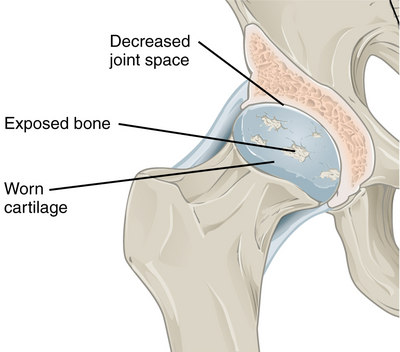◔
Hip Osteoarthritis: Difference between revisions
From WikiMSK
No edit summary |
No edit summary |
||
| Line 1: | Line 1: | ||
{{stub}} | {{stub}} | ||
[[File:0910_Oateoarthritis_Hip_A.png|thumb|right|400px|Hip osteoarthritis]] | [[File:0910_Oateoarthritis_Hip_A.png|thumb|right|400px|Hip osteoarthritis]] | ||
==Epidemiology== | |||
The prevalence of radiographic hip osteoarthritis is 18.2% in men and 14.3% in women<ref>Iidaka T, Muraki S, Akune T, et al. Prevalence of radiographic hip osteoarthritis and its association with hip pain in Japanese men and women: the ROAD study. Osteoarthritis Cartilage. 2016;24(1):117–123. [https://doi.org/10.1016/j.joca.2015.07.017 DOI]</ref> | |||
==Aetiopathogenesis== | |||
*Higher bone density can drive knee osteoarthritis but not hip osteoarthritis | *Higher bone density can drive knee osteoarthritis but not hip osteoarthritis | ||
==Clinical Features== | ==Clinical Features== | ||
There is no clear association between pain levels and radiographic severity of hip osteoarthritis. Up to 40% of patients with hip osteoarthritis have no pain. Patients with higher pain levels showed differences in sensitisation as measured by quantitative sensory testing.<ref name="hattori">Hattori T, Shimo K, Niwa Y, Tokiwa Y, Matsubara T. Association of Chronic Pain with Radiologic Severity and Central Sensitization in Hip Osteoarthritis Patients. J Pain Res. 2021;14:1153-1160 [https://doi.org/10.2147/JPR.S296273 DOI]</ref> | There is no clear association between pain levels and radiographic severity of hip osteoarthritis. Up to 40% of patients with hip osteoarthritis have no pain. Patients with higher pain levels showed differences in sensitisation as measured by quantitative sensory testing.<ref name="hattori">Hattori T, Shimo K, Niwa Y, Tokiwa Y, Matsubara T. Association of Chronic Pain with Radiologic Severity and Central Sensitization in Hip Osteoarthritis Patients. J Pain Res. 2021;14:1153-1160 [https://doi.org/10.2147/JPR.S296273 DOI]</ref> | ||
==Prognosis== | |||
*A minority have clear cut clinical and radiological recovery, especially with marked osteophytosis and concentric disease | |||
*Superolateral migration of the femoral head is correlated with more rapid osteoarthritis progression, also with atrophic bone response | |||
==Treatment== | ==Treatment== | ||
Total hip joint replacement is usually effective for reducing pain. However 10% of patients have chronic postsurgical pain, and preoperative central sensitisation has been thought to be a risk factor for this.<ref name="hattori"/> | Total hip joint replacement is usually effective for reducing pain. However 10% of patients have chronic postsurgical pain, and preoperative central sensitisation has been thought to be a risk factor for this.<ref name="hattori"/> | ||
==Resources== | |||
*Dieppe PA good author to read | |||
==References== | ==References== | ||
<references/> | <references/> | ||
{{Reliable sources}} | {{Reliable sources}} | ||
[[Category:Hip Joint]] | [[Category:Hip Joint]] | ||
[[Category:Osteoarthritis]] | [[Category:Osteoarthritis]] | ||
[[Category:Stubs]] | [[Category:Stubs]] | ||
Revision as of 09:24, 23 April 2021
This article is a stub.
Epidemiology
The prevalence of radiographic hip osteoarthritis is 18.2% in men and 14.3% in women[1]
Aetiopathogenesis
- Higher bone density can drive knee osteoarthritis but not hip osteoarthritis
Clinical Features
There is no clear association between pain levels and radiographic severity of hip osteoarthritis. Up to 40% of patients with hip osteoarthritis have no pain. Patients with higher pain levels showed differences in sensitisation as measured by quantitative sensory testing.[2]
Prognosis
- A minority have clear cut clinical and radiological recovery, especially with marked osteophytosis and concentric disease
- Superolateral migration of the femoral head is correlated with more rapid osteoarthritis progression, also with atrophic bone response
Treatment
Total hip joint replacement is usually effective for reducing pain. However 10% of patients have chronic postsurgical pain, and preoperative central sensitisation has been thought to be a risk factor for this.[2]
Resources
- Dieppe PA good author to read
References
- ↑ Iidaka T, Muraki S, Akune T, et al. Prevalence of radiographic hip osteoarthritis and its association with hip pain in Japanese men and women: the ROAD study. Osteoarthritis Cartilage. 2016;24(1):117–123. DOI
- ↑ 2.0 2.1 Hattori T, Shimo K, Niwa Y, Tokiwa Y, Matsubara T. Association of Chronic Pain with Radiologic Severity and Central Sensitization in Hip Osteoarthritis Patients. J Pain Res. 2021;14:1153-1160 DOI
Literature Review
- Reviews from the last 7 years: review articles, free review articles, systematic reviews, meta-analyses, NCBI Bookshelf
- Articles from all years: PubMed search, Google Scholar search.
- TRIP Database: clinical publications about evidence-based medicine.
- Other Wikis: Radiopaedia, Wikipedia Search, Wikipedia I Feel Lucky, Orthobullets,



